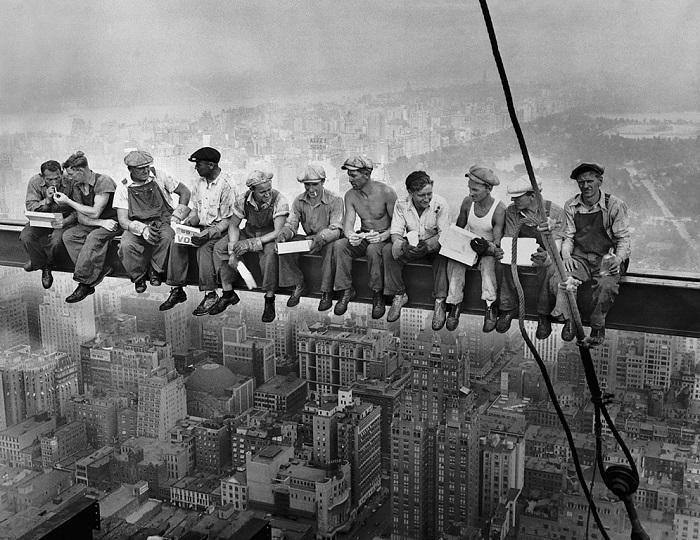Roughnecks in the Clouds: The Dangerous Construction of Manhattan’s Skyscrapers
Well, howdy, folks! I’m here with a tale of grit, determination, and some good ol’ fashioned danger. I came across a YouTube video from the Smithsonian Institute that had me on the edge of my seat. It’s called “These Men Risked Their Lives to Build 1920s New York Skyscrapers,” and let me tell you, it’s a doozy. This segment from their documentary “America in Color: The 1920s” takes us through the construction of some of the tallest buildings in Manhattan, like the Chrysler Building and the Empire State Building. But what really got me was how these workers, known as roughnecks, put their lives on the line every day without any safety equipment. It’s astonishing to me that they spent their eight-hour shifts in the clouds, without any safety equipment, risking everything for the sake of building these towering structures. It’s a remarkable story that reminds us just how far we’ve come in terms of workplace safety.
The video above describes the construction of some of the tallest skyscrapers in Manhattan, including the Chrysler Building and the Empire State Building. The construction of these buildings was dangerous, and workers were without safety equipment, such as harnesses and hard hats. The working men, known as roughnecks, spent eight-hour shifts in the clouds and were at risk of falling to their deaths or ending up disabled. Former New York governor Al Smith actively promoted the construction of the Empire State Building, which was intended to be a symbol of New York’s wealth and power.
The contrast between the early era of skyscraper construction and the current focus on workplace safety is stark. Workers in the 1920s endured grueling labor conditions, with little to no protection or safety equipment. Today, we take for granted the extensive safety regulations and standards that protect workers, with technology testing machines and equipment before they are put into service. Building skyscrapers was a war of construction against the forces of nature, where accidents, maimed bodies, and even death were a grim reality.
It’s hard to imagine a time when the towering structures were nothing but a dream. The early era of skyscraper construction was a time when the industry barons raced each other to build the tallest tower in the world. Workers had few protections, no hard hats, and no safety ropes. It was a time when crew foremen expected one man to die for every $1 million spent on a skyscraper.
In these heady early years, workers had to endure grueling labor conditions and put their lives on the line every day. During the breakneck construction of the Empire State Building from 1929 to 1931, five workers died in accidents, with an estimated 27 workers perishing during the construction of the Brooklyn Bridge. But even inches from peril, some men managed to laugh in the face of death, as incredible pictures show construction workers goofing off as they built America’s most iconic skyscrapers.
Surprisingly, no workers died constructing the Chrysler Building, completed in 1930 after two quick years of construction. However, the speedy pace at which the building was finished and the absence of safety equipment made it one of the most dangerous jobs in the world.
Building skyscrapers in the 1920s was the nearest peace-time equivalent of war. The analogy is startling, even to the occasional grim reality of a building accident where maimed bodies, and even death, remind us that we are fighting a war of construction against the forces of nature.
It’s difficult to imagine working without safety equipment or protection, but that was the reality for construction workers in the early 20th century. Today, we take safety regulations and standards for granted, with sophisticated computer models testing machines and equipment before they’re ever placed on an assembly line or put into service. Thanks to the rise of unions in the 1920s and 1930s, the introduction of workers’ compensation in the 1940s and 1950s, and the introduction of Occupational Safety and Health Administration standards in 1970, companies discovered that there is a direct relationship between their safety record and their insurance costs.
References:
- https://workforce.com/news/playing-it-safe-a-look-at-workplace-safety-during-the-roaring-20s-and-now
- https://commons.wikimedia.org/wiki/File:Lunch_atop_a_Skyscraper.jpg
- https://www.si.edu/object/yt_gDN4c2wnx3E
- https://www.forconstructionpros.com/blogs/construction-toolbox/blog/12096401/looking-back-on-the-worlds-deadliest-construction-projects
- https://blog.trestlescs.com/a-look-back-during-the-early-era-of-skyscraper-construction
- https://www.nyc.gov/assets/doh/downloads/pdf/survey/construction-fatalities.pdf
- https://en.wikipedia.org/wiki/Chrysler_Building
- https://www.fastcompany.com/90619078/these-are-the-worlds-deadliest-construction-projects
- https://www.citysignal.com/the-dark-history-of-the-empire-state-building/
- http://web.archive.org/web/20210730140317/https://www.iccsafe.org/building-safety-journal/bsj-dives/the-human-cost-of-construction-an-inside-look-at-the-worlds-most-notable-and-deadliest-construction-projects/










